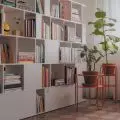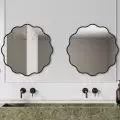Work submitted for the competition
"Best Diploma Architecture".
The subject of the study is the design of the museum of the last nuclear bomb in Kurchatovo (Kazakhstan). The project area is located in the area of former nuclear training grounds. At the vast 19,000-square-kilometer area of the Semipalatinsk training ground in 1949, the armed forces of the Soviet army conducted their first nuclear weapons test. Over the next forty years, a total of 467 nuclear explosions were carried out, with little care for the local population or the environment. In 1991, after Kazakhstan's independence, the test sites were officially closed. Kurchatov was the site where the administration and managers of the testing ground were based.
axonometry of the building and concept sketch
© Natalia Guzior
The project focuses on transforming the area, which was once a symbol of danger and destruction, into a place for education, reflection and dialogue on peace and global security. The designed museum becomes a tourist center that allows visitors to go out to the testing ground, thus revitalizing the analyzed areas. The interactive form of presenting the problem allows for a better understanding of the scale and consequences of nuclear activities. The global issues surrounding the nuclear arsenal are topical and pose a serious challenge to international security. The project exemplifies the use of architecture as a mediating tool in the context of nuclear weapons threats.
contrast
The entrance to the building is a key element of the design, setting the mood for visitors. I decided to design the entrance in the form of a narrow gap. This architectural decision was dictated by the desire to evoke a feeling of uncertainty and mild discomfort in visitors, which is meant to make them reflect on the experience of crossing the
boundaries.
view of the entrance
© Natalia Guzior
Despite its limited width, the gap was designed with ergonomic principles in mind to ensure the comfort and safety of users. The entrance to the building is also meant to draw attention to the need to slow down and focus on the present moment. When entering the building, visitors must slow down and think carefully about every move, which is meant to put them in a state of heightened attention and readiness for what's inside.
viewing window
© Natalia Guzior
emotions
I included an inverted metaphor in the design to show what we can lose. In the body of the building I cut out a circle symbolizing a crater left by a nuclear bomb explosion, and inside this crater I designed a floral meadow associated with a carefree, colorful life, which can be irretrievably lost in an instant.
floral meadow
© Natalia Guzior
In the western part of the building there is a contemplation space that opens up to two perspectives. On the one hand, the observer can admire the colorful circle, full of life and color, while on the other the view opens up to the devastated areas of Kazakhstan. In this way, I wanted to evoke in visitors a feeling of being torn between beauty and destruction, to create a place that makes them reflect on the fragility of life and the potential consequences of our actions. I aimed to make everyone who visits the place feel strong emotions and reflect on the values of peace and beauty that we need to protect.
passage
A unique route leads to the museum, along which 195 wooden posts are driven into the ground. These symbolic elements represent the unity of all the countries of the world. The space has been carefully planned so as not to lose the spirit of the place, but rather to emphasize the metaphysical emptiness and lack that is felt here. Stepping along the path leading to the museum, visitors are introduced to the narrative of the tragedy.
The pedestrian path to the museum and the view of the exhibition along the circle
© Natalia Guzior
The silence that accompanies the path is interrupted only by the subtle hum of the grasses, enhancing the emotional experience. My goal was to create a space that protects the memory of the past and allows visitors to reflect deeply on the tragic events that took place. The natural surroundings, with their indelible memory, are an integral part of the experience. Nature remembers, and in its hum, in its silence, visitors can confront the difficult past, finding both sadness and strength in it.
A view of the inner courtyard and the symbolic globe
© Natalia Guzior
material
Kazakhstan is a country much of which is occupied by clay and sand deserts, such as Kyzyl-kum and Mujun-kum, and rainfall is almost non-existent here. Faced with the natural conditions, to minimize the generation of unnecessary waste, I decided to use compacted earth wall technology, which uses natural materials available in the region, also eliminating the need to transport materials using fossil fuels. Compacted earth walls have excellent thermal properties: they absorb heat during the day and give it back at night when the air temperature drops. Thanks to this solution, the costs associated with heating and cooling the building are significantly reduced. These walls are characterized by exceptional durability and do not require maintenance for many years.
rammed earth walls
© Natalia Guzior
Natalia GUZIOR
Illustrations: © Author





































































































